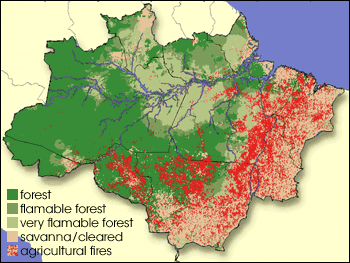| |
Controlling those triggers, says Nepstad, isn’t easy in a social climate where fire has come to be viewed as a ‘chronic emergency.’ “Every few years,” he explains, “there will be a really bad fire season, where smoke closes airlines and parks and preserves are threatened. Then there is a knee-jerk reaction among the media and some in the government to treat it as a sudden emergency that you can only combat by throwing firefighting resources at it, rather than seeing the fires with a long-term perspective, which would cause you to see that poor frontier management is causing it.”
The ever-present threat of fires traps local people into superficial uses of the land that don’t require much investment. These superficial uses are also called “extensive land use” because they encourage people to make minimal use of a large extent of land, rather than putting a smaller area of forest to more intensive use. “Every farmer or landowner you talk to has a story,” says Nepstad, “about how his neighbor’s cattle-pasture fire got out of control and burned into his property. He’ll say, ‘Yeah, I used to have some orange trees,’ or something, ‘but they got burned up by my neighbor’s pasture fire.’“ |
|
  |
| |

Those stories draw attention to how difficult it is to escape the cycle of accidental fire. Logging causes fire; drought causes fire; fire causes fire. With the increasing threat of fire, landholders are reluctant to use their land for anything that might be wiped out by fire or to spend their money on fire prevention measures on their own property when they are just as threatened by their neighbor’s land management decisions. Nobody wants to try to maintain a plot of sustainably harvested timber land if it is just going to get burned up when the neighbor’s pasture fire gets out of control. |
|
Frequent fires along the developing margin of the Amazon discourage settlers from improving their land. As a result, landholders graze cattle or abandon their property when the land becomes infertile. These types of land use increase the frequency of fire, further discouraging land management practices that better preserve the forest. (Photograph courtesy Compton Tucker, NASA GSFC) |
| |

Instead, land owners anticipate failure, and when it happens, they just move deeper into the forest. In the wake of slash-and-burn operations both big and small, the Amazon is being transformed from forest to savanna, and thousands of species of plants, animals, fungi, and bacteria are likely being lost to extinction—living organisms that in addition to their own innate value have also been a source of everything from food to furniture to pesticides to medicines. Looking into the future of his study area around Paragominas and Tailândia, Brazil, Cochrane wrote in 1999:
Left unchecked, the current fire regime will result in an inexorable transition of the entire area to either scrub or grassland. Effects on the regional climate, biodiversity, and economy are likely to be severe. These fire-induced changes will take several years to occur, but are likely to be irreversible under the current climate conditions.
How many years are “several”? Nepstad hesitates. “Let’s see how prepared Brazil is for the next El Niño—and how quickly the next El Niño comes back.”
 Amazonia’s Future Amazonia’s Future
 Hidden Impacts of Fires and Logging Hidden Impacts of Fires and Logging
|
|
Fires are widespread along the south and east edges of the Amazon, and flammable forests are located deep in the heart of the region. Fire threatens to transform the dense rainforest into scrub and grassland. This map shows the state of the forest and occurence of fires in 1998. (Map adapted from Nepstad et al., 2001) |

